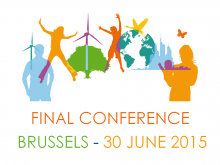This report assesses the effectiveness of typified policy packages that aim at facilitating a substantial transformation of the European energy system, in order to reach a reduction of GHG emissions of 80-95% by 2050 (against 1990 levels). The report first details the medium (by 2030) and long-term (by 2050) key infrastructure requirements and characteristics based on energy system modelling, by both supply and end-use sectors. Subsequently, the report presents three policy packages for delivering this infrastructure, based on three different policy paradigms.
read morePublications
- Policy Briefs
- Conference Reports
- Work Package 1: Taking stock of the current instrument mix
- Work Package 2: Sectoral impacts of the current instrument mix
- Work Package 3: Future-looking scenarios
- Work Package 4: Policy pathways to a future instrument mix(active tab)
- Work Package 5: The international context
- Work Package 6: Towards an ‘optimal’ instrument mix for climate policy
- Related Publications
Although uncertainty is widely recognised as a key issue in the climate change issue, most economic models used to assess the greenhouse gas (GHG) abatement policy mix are deterministic. This report aims at filling this gap by developing a simple stochastic model of the European energy sector featuring the most important uncertainty sources in this context, including the economic activity in CO2-intensive sectors and the cost of key technologies, as well as the interaction between climate policy and renewable energy subsidies.
read moreThis document explores the different choices of policy instruments that the EU could select to reduce its GHG emissions by 80% compared to 1990 levels in 2050. It presents three different policy packages that could be implemented to achieve this reduction, each including carbon pricing as well as policies to promote technological and behavioural change: a market driven pathway based on economic instruments with the EU ETS as its centrepiece, a technology-specific pathway, and a pathway that builds primarily on the mitigation potential of behavioural change.
read moreThis report presents the results of the CECILIA2050 research concerning the political feasibility of climate policy instruments in the EU. The study analyses how political factors affect the design of climate policy instruments and which lessons can be drawn from this for future instrument design choices. The study analyses three factors, namely interest groups’ preferences, power constellations, and institutions.
read moreWhile the current macroeconomic setting is slowly moving towards financing the green/low carbon economy, complementary fiscal and monetary policies as well as private and public investments are needed to facilitate this transition. This report analyses the role of finance and banking among the factors that support the adoption of eco innovation in the realms of energy efficiency and CO2 abatement. It finds that firms need additional external financial support to successfully contribute to achievement of the EU’s 2050 climate and energy policy targets.
read moreThe study specifies potential bottlenecks in the supply of material resources due to effective climate policy in the longer term towards 2050, but indicates longer duration developments as well. A second part of the analysis is about how such bottlenecks may strategically be overcome. The focus is on the metallic elements.
read moreThe European Union (EU) has set itself emission reduction targets of 40% by 2030 and 80-95% by 2050 compared to 1990 levels. However, research finds that the current policy instrument mix needs to be strengthened considerably to reach these targets. This report addresses two key questions that are frequently raised in this context:
read more


